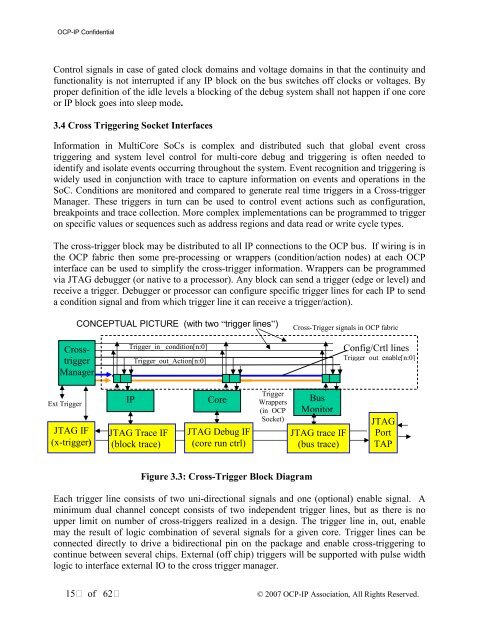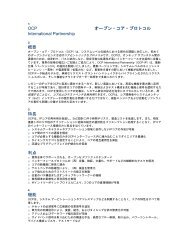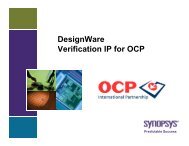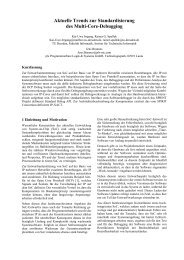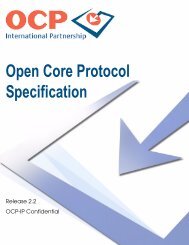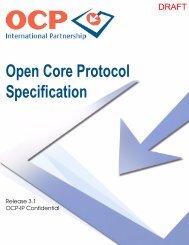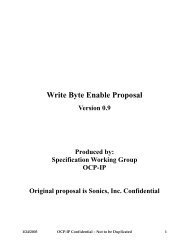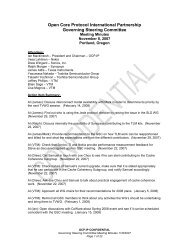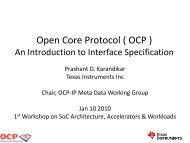Open Core Protocol Debug Interface Specification rev 1.0 - OCP-IP
Open Core Protocol Debug Interface Specification rev 1.0 - OCP-IP
Open Core Protocol Debug Interface Specification rev 1.0 - OCP-IP
Create successful ePaper yourself
Turn your PDF publications into a flip-book with our unique Google optimized e-Paper software.
<strong>OCP</strong>-<strong>IP</strong> Confidential<br />
Control signals in case of gated clock domains and voltage domains in that the continuity and<br />
functionality is not interrupted if any <strong>IP</strong> block on the bus switches off clocks or voltages. By<br />
proper definition of the idle levels a blocking of the debug system shall not happen if one core<br />
or <strong>IP</strong> block goes into sleep mode.<br />
3.4 Cross Triggering Socket <strong>Interface</strong>s<br />
Information in Multi<strong>Core</strong> SoCs is complex and distributed such that global event cross<br />
triggering and system level control for multi-core debug and triggering is often needed to<br />
identify and isolate events occurring throughout the system. Event recognition and triggering is<br />
widely used in conjunction with trace to capture information on events and operations in the<br />
SoC. Conditions are monitored and compared to generate real time triggers in a Cross-trigger<br />
Manager. These triggers in turn can be used to control event actions such as configuration,<br />
breakpoints and trace collection. More complex implementations can be programmed to trigger<br />
on specific values or sequences such as address regions and data read or write cycle types.<br />
The cross-trigger block may be distributed to all <strong>IP</strong> connections to the <strong>OCP</strong> bus. If wiring is in<br />
the <strong>OCP</strong> fabric then some pre-processing or wrappers (condition/action nodes) at each <strong>OCP</strong><br />
interface can be used to simplify the cross-trigger information. Wrappers can be programmed<br />
via JTAG debugger (or native to a processor). Any block can send a trigger (edge or level) and<br />
receive a trigger. <strong>Debug</strong>ger or processor can configure specific trigger lines for each <strong>IP</strong> to send<br />
a condition signal and from which trigger line it can receive a trigger/action).<br />
CONCEPTUAL PICTURE (with two “trigger lines”)<br />
Cross-Trigger signals in <strong>OCP</strong> fabric<br />
Crosstrigger<br />
Manager<br />
Trigger_in_ condition[n:0]<br />
Trigger_out_Action[n:0]<br />
Config/Crtl lines<br />
Trigger_out_enable[n:0]<br />
Ext Trigger<br />
JTAG IF<br />
(x-trigger)<br />
Trigger<br />
<strong>IP</strong> <strong>Core</strong> Wrappers<br />
Bus<br />
Monitor<br />
JTAG Trace IF<br />
(block trace)<br />
JTAG <strong>Debug</strong> IF<br />
(core run ctrl)<br />
(in <strong>OCP</strong><br />
Socket)<br />
JTAG trace IF<br />
(bus trace)<br />
JTAG<br />
Port<br />
TAP<br />
Figure 3.3: Cross-Trigger Block Diagram<br />
Each trigger line consists of two uni-directional signals and one (optional) enable signal. A<br />
minimum dual channel concept consists of two independent trigger lines, but as there is no<br />
upper limit on number of cross-triggers realized in a design. The trigger line in, out, enable<br />
may the result of logic combination of several signals for a given core. Trigger lines can be<br />
connected directly to drive a bidirectional pin on the package and enable cross-triggering to<br />
continue between several chips. External (off chip) triggers will be supported with pulse width<br />
logic to interface external IO to the cross trigger manager.<br />
15 of 62<br />
© 2007 <strong>OCP</strong>-<strong>IP</strong> Association, All Rights Reserved.


